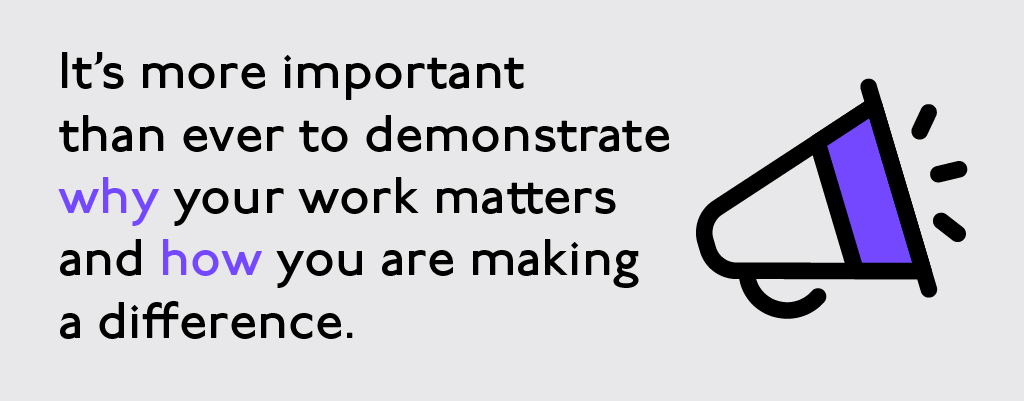It seems like fundraisers are faced with a new set of challenges every year. It comes with the territory. And the most successful nonprofits are always looking for ways to adjust and improve their outreach. Organizations that have been willing to pivot are the ones are raising money during the pandemic.
COVID-19 has created many new challenges for fundraisers. And many of us are trying to keep up with the best ways to engage our audiences and raise money during the pandemic.
So, whether your fundraising took a big hit in 2020 and you’re looking for ways to make up on lost revenue, or you’re looking for new ways to get ahead as this crisis continues, you can learn a lot from what other fundraisers have done throughout the year.
Here are five of the most impactful ways nonprofits are raising money during the pandemic:

1. It starts with why.
Communicating what makes your work so important during the pandemic comes naturally for organizations on the pandemic’s frontlines. For example, healthcare organizations and food pantries have critical needs that are easy to explain to donors.
But what if your nonprofit is less involved with the pandemic directly? How can you get donors to care about your mission when the needs of frontline organizations seem so much more pressing?
Remember, another organization’s immediate need does not diminish your own, or the importance of your work. And the people who supported you before the pandemic still care about your mission.
The world has changed a lot during the past year. And these changes, including being away from friends and family, spending significantly more time at home, or losing a loved one, have been tough for many of us.
So, no matter what your work involves, think about ways you’re helping people take care of their mental health during these challenging times.
For example, an animal shelter can share a story about a someone who was struggling with isolation and adopted a cat to help them feel less lonely. Or a family who lost someone to COVID-19 and adopted a dog to help the children cope with the loss.
READ MORE: COVID-19 – Speaking to the Importance of Your Nonprofit’s Work
2. Make it easy for them to give you money. Seriously.
But you can’t just change the message in your stories and hope to see results. Nonprofits that are raising money during the pandemic know an optimized online donation page is key for securing support during these challenging times.
Making it easy for donors to support you digitally will help make up on revenue lost from canceled events, lower response rates or average gift sizes, and other setbacks throughout the year.
Cutting the clutter from your online donation page is the first step.
There are plenty of places on your website where supporters can learn about your initiatives and the details behind them.
So, don’t clog up your online donation page with extra information! Keep it focused on securing support and make sure it’s clear you want people to donate.
You should also offer multiple forms of payment for donors who want to support you. New donors may not want to put their credit card info into a website they just discovered. So, consider using a secure third-party platform like PayPal as another payment option!
And don’t forget to make it easy for donors to give by limiting the amount of time they spend on your online giving page.
Keep any forms short and only ask for information that is essential to securing a donation! Long forms can intimidate donors and cause them to leave your page before they give.
READ MORE: Securing Support Through Your Online Donation Page

3. Improve your aim.
Nonprofits will look for ways to cut down on their budget and spending when revenues go down. You may think you have no choice but to furlough part of your development staff.
But this could be a huge mistake! After all, you need these people to reach your audience and secure support.
So, letting them go is like letting your car run out of gas instead of filling up when your fuel light goes on.
It will be extremely difficult to regenerate fundraising momentum if you are short staffed.
Instead, you can use more targeted mail to cut down on print and mailing costs. You may have shifted to a digital-first strategy. But direct mail is still an important piece of the fundraising puzzle!
You can reduce costs and improve your ROI by sending print appeals only to donors who are most likely to give through direct mail.
Your database will help you determine who your most important direct mail only donors are. Or, you can send a donor survey and ask your audience if they would prefer to receive digital communications only.
You can move many of your direct mail communications to email for those who are not really interested in your direct mail appeals anyway!
Being more targeted with your direct mail now will also help you in the long run. You may find that you can still secure support while cutting costs. This leaves more money to help you further your goals.
And as a bonus, what you learn now can help you be smarter with your solicitations for years to come!
READ MORE: COVID-19: Four Ways to Regenerate Fundraising Momentum
4. Don’t be that person.
Let’s say you have a friend that never seems shy to ask for a favor but always disappears when you need one in return. How long are you going to keep helping them? Or even returning their calls? Come to think of it, did the ever even say thank you?
The number one reason why donors stop giving to organizations is fatigue from receiving ask after ask without receiving enough love.
And now, it’s more important than ever to maintain relationships with your donors by using non-ask communications.
If revenue is down, you want to hit the ground running when donors are ready to give. And they will be more open to giving if you show them you still care, even if they can’t support you right now.
So, if you haven’t already, pick up the phone and give important donors a call to check in. Or, call them again if it’s been a few months since you’ve reached out! An unexpected call from a friendly voice could be a welcome surprise during these difficult times.
Ask your donors how they and their loved ones are holding up. Be personal and ask how they’ve been passing the time.
Focus on the donor. Let them know that these difficult times make you appreciate their past support even more!
Then, talk a little bit about what your organization is up to during the pandemic. Remember, your loyal donors are invested in your mission. And they want some good news and to hear what you’ve been up to!
But stop short of making an ask. Express your gratitude for past support and let them know you are looking forward to getting back to normal. Wish them the best and invite them to keep in touch!
A phone call is not the only way to keep donors engaged. Consider putting together a special impact report to let donors know everything they’ve helped you accomplish this year. Or, send donors a photo from your most recent event and let them know you’re looking forward to when you can see them again!
READ MORE: COVID-19: Maintaining Relationships with Non-Ask Communications

5. It just makes cents.
The pandemic has not changed the reasons someone supported your organization in the past. However, it may have impacted their ability to give the way they usually do.
According to the Fundraising Effectiveness Project’s Q2 2020 Report, the number of gifts below $250 are up 19.2 percent compared to the first half of 2019. And more donors are giving to organizations they’ve previously supported.
So, what’s going on here?
Let’s say you usually receive a $250 donation at the end of the year from a specific donor. However, you notice they gave five $50 gifts throughout the year instead.
This isn’t uncommon given the economic uncertainty surrounding the pandemic. The donor still wanted to make an impact, but it may not have been the best idea to donate all that money at once this year. They could have lost money in the stock market, had hours cut at work, or just wanted to play it safe and avoid making a large donation with so much up in the air!
But what does this mean?
Nonprofits that are raising money during the pandemic are focusing on communicating the impact every donation makes.
They understand donors may not give the way they usually do. So, they stress the fact that every dollar makes an impact!
They find ways to secure donations, no matter how small. During the 2020 election period, we all heard “Chip in a $1 to join our cause” ad nauseum. But there’s something to be said of five million donors giving an average of $18 to a cause!
So, how can you secure these valuable, small dollar donations?
#GivingTuesday and other social media campaigns are a great way to get new audiences to pitch in a few dollars. But you should also promote your own monthly giving program and consider using less aggressive ask strings until the pandemic subsides.
READ MORE: 5 Ways to Show the Impact of Every Donation
The lessons we learned in 2020
There is never really a “normal” year for fundraisers. There’s always a new challenge on the horizon. But this year, nonprofits were thrown a trickier curve-ball than expected.
Above all, the most important lesson we learned in 2020 is to be flexible. News around the pandemic changes rapidly. So, there’s only so much we can do to anticipate what will come next!
Instead, fundraisers everywhere need to pick up on trends where we can and maximize our efforts to keep donors engaged.
Adjusting your message, optimizing your donation page, cutting down on mailing costs, keeping audiences engaged with non-ask communications, and focusing on small dollar donations have helped nonprofits raise money during the pandemic.
So, think about ways you can learn from other fundraisers and use these strategies in your own approach going forward!







